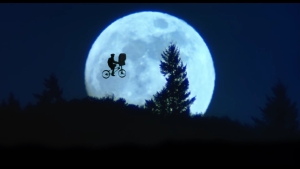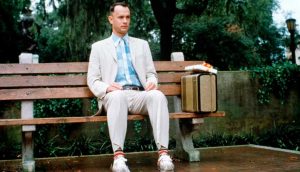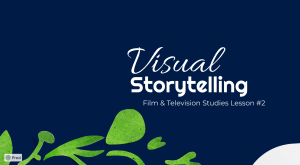25 Visual Storytelling
Learning Objectives
-
Explore visual storytelling as a powerful medium for evoking psychological and emotional responses from readers.
-
Cite specific textual evidence to support inferences and conclusions drawn from the text.
Chapter & Discussion
This chapter includes a presentation that can be navigated in a classroom setting or independently. You can access the presentation via the link below.
Film Studies: Visual Storytelling
Work through the different sections of the chapter and discuss ideas and topics as they arise. If you’re working independently, take notes instead. Notes and active discussion will be helpful in navigating this week’s assignments.
Visual Media
Film and television are visual media. Their goal is to tell stories using not only the principles of literature, but also through images.
Where the camera is placed, how it moves, how a shot uses light and color, and how the actors are positioned all have psychological and emotional effects on the audience. These seemingly small choices can create deeper meaning that you would not just find in the plot summary.

Mise en Scene
Translation: What’s in the frame?
There are hundreds of choices that are made by directors and production designers that determine what the audience sees.
These choices can ultimately have a major impact on how audiences experience and interpret a film.
Style & Aesthetics
The aesthetics of a film are what the audience sees. This can include camera work, special effects, production design, and even the camera lenses used.
The style of a film is how the director uses these elements to say what they have to say (communicate themes)
Realism vs Formalism
One way you can discuss the style of a movie is using a spectrum of realism vs formalism.
Realism is the attempt to capture a realistic portrayal of life/society as we know it.
Formalism is an attempt to see the world through the lens of an idea. This makes things distorted and artistic.
Most films fall somewhere in the middle, which we call Classicism.

Blocking and Camera Movement
Composition of images isn’t unique to film. But, film has a very unique quality: movement.
Directors have to control the movement of the actors and the camera, which is known as blocking.
Some basic blocking includes the three major shots: a wide shot, a medium shot, and a close-up. These tell us how close or far away the actors are in the frame.
- Panning is when the camera turns left or right
- Tilting is when the camera turns up or down
- Zooms increase or decrease the frame to a single point
- Tracking is a shot where the camera moves through space, usually following someone
- Crane & helecopter shots create large zoom effects and movement through space
- A handheld shot can give a scene a sense of realism because the camera operator moves naturally as they shoot
The blocking can also determine a scene’s perspective. An objective scene looks at the action as an outsider with no emotion or influence. A subjective scene conveys how a character is feeling and tells the story from their point of view.
Lighting and Color
Lighting and color can influence the mood and atmosphere of a film.
High-key lighting is when a film is well-lit, offering a better-than-reality vision of the story.
Low-key lighting creates drama and suspense using shadows and a single light source.
Directors and production designers also use color to communicate ideas. This is called a film’s palette. It can be affected by costumes, lighting, and even filters in post-production.
Assigned Reading
Here are this week’s readings. Additionally, please read for your own personal enjoyment for 1/2 hour each day. This will be called your “Reading Zone” reading and it will coincide with many upcoming activities.
Cinematography by Russel Sherman (via Moving Pictures)
Problem Set: Practice Your Skills!
Click here to complete a ten-question problem set on concepts in this chapter.
Completing problem sets like this can be an important element of independent study towards completing your HSE. I write these to resemble the style of questions you’ll find on the Reading and Language Arts GED.
Assignment: Observing & Questioning (250 Words)
We’re going to practice the “Observing and Questioning” method for finding themes. Pick one of your favorite movies (or a short film from The New Yorker Short Films Playlist) and answer the following prompts:
1. Summarize the major story beats.
2. What the goals are for these major points?
3. Simplify your answer to make it as short as possible.
Once completed, please comment on someone else’s response.
Assignment: Reading Zone Response (250 Words)
For Reading Zone, you must find a novel that is interesting to you and enjoyable to read. If you need help finding a Reading Zone book, please ask. Please read your Reading Zone book for a half-hour each day. On class days, there will be time in class dedicated to reading.
Create a response to this week’s reading that addresses the following prompts:
-
In one paragraph, summarize what you’ve read this week
-
In a second paragraph, describe the author’s use of imagery. Tell me about a scene where the author used vivid imagery. What were they up to?
Attributions
Sharman, R. Moving Pictures. University of Arkansas Libraries Open Educational Materials. 2020.
Willems, P.H. How to Analyze Movies. Nebula. Jan 30, 2023.


